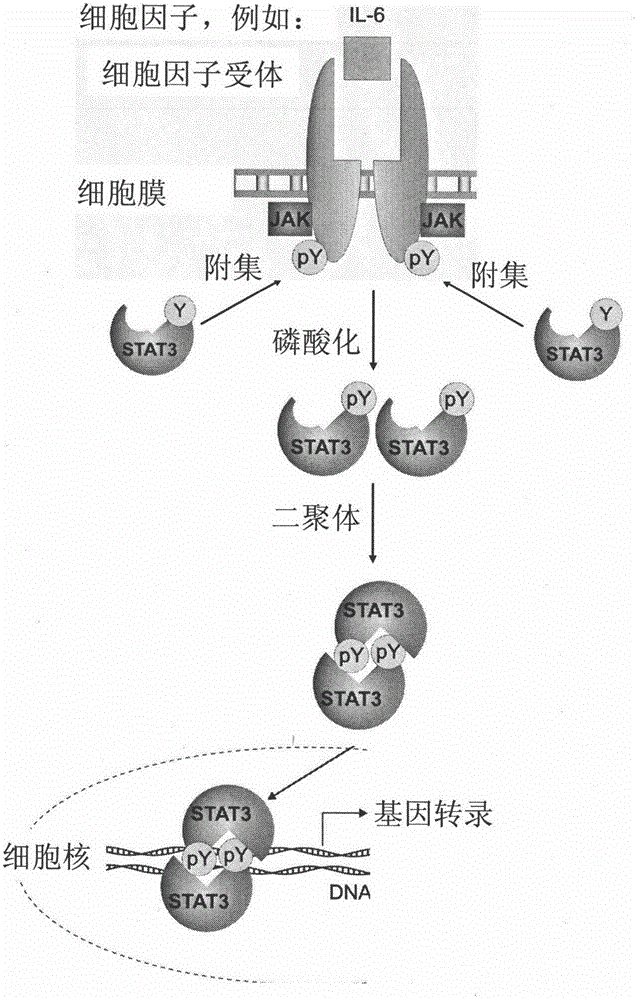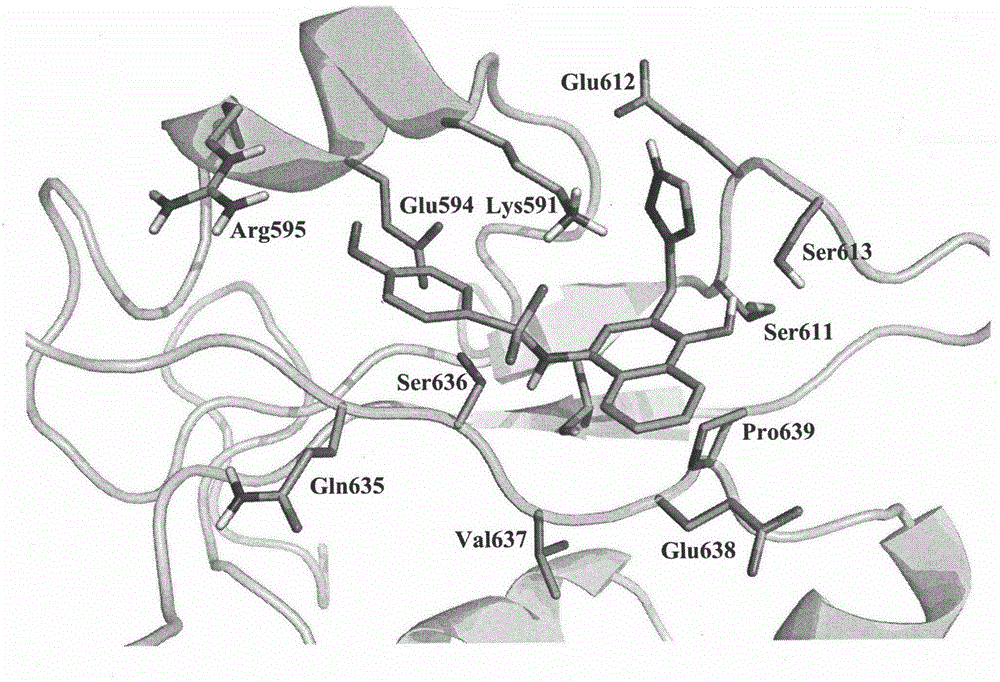Target anti-cancer medicine based on STAT3 (Signal Transducers and Activators of Transcription type 3) protein target spot
A drug and cancer technology, applied in the field of signal transduction system inhibitor compounds, can solve the problems of no improvement in the biological activity of compounds, difficulty in modifying natural compounds, and easy drug resistance
- Summary
- Abstract
- Description
- Claims
- Application Information
AI Technical Summary
Problems solved by technology
Method used
Image
Examples
Embodiment 1
[0021] Embodiment 1: Molecular docking (docking) experiment
[0022] METHODS: In order to provide a set of reasonable computer-predicted selective target-attack chemical probes for Stat3, we used the phosphorylated tyrosine (pY-705) binding region of the SH2 region of Stat3 as the docking site, It mainly includes phosphorylated tyrosine interaction site R609 and hydrophobic interaction site W623. The structural coordinates of Stat3 SH2 were obtained from the protein structure database (PDB data bank, ID: 1BG1). The selected chemical compound library is LIFE CHEMICALS. Molecular docking method: All computer coordination simulation (docking) experiments were completed on the Schrodinger-Maestro operating platform, and the computer coordination simulation (docking) tool used was Glide. First, take Stat3 SH2 out of the PDB data bank and download it to the Schrodinger operating platform - Maestro. After dehydration, add hydrogen atoms and charges to the amino acids of Stat3 SH2 ...
Embodiment 2
[0023] Example 2: BIAcore experiment
[0024] Method: The experiment of the interaction between the selected compound and Stat3 molecules (BIAcore) is at 25°C, the phosphorylated polypeptide is immobilized on the BIAcore 3000 biochip (biosensor) attached to streptavidin, and the flow buffer used is 20mM at pH8 Concentration of Tris buffer contains 2mM concentration of mercaptoethanol and 5% DMSO aqueous solution, and its flow rate is 10uL / min. Before the test, Stat3 protein at a concentration of 500nM was mixed with the selected compound to a predetermined concentration of 0.1, 0.5, 1, 5, 10, 50, 100, 500uM. After each test, the biosensor was rinsed with 10 uL of 100 mM glycine at pH 1.5 for the next test. Stat3 protein at 500 nM without drug mixture was tested once from start to finish to ensure that the entire test system was always functioning normally (6). Experimental (BIAcore) result analysis: The characteristic curve of the BIAcore signal of different concentrations o...
Embodiment 3
[0025] Example 3: Western blot
[0026] Method: Experimental method of Western blot: Human hepatocellular carcinoma cells (HepG2) were cultured in a six-well plate under standard conditions. Cells were treated with compounds at different concentrations - 0.5, 1, 5, 10 (uM) and incubated for 1 hour. Cells were treated with IL-6 at a concentration of 30 ng / ml and incubated for half an hour to stimulate Stat3 phosphorylation. After the cells are harvested, proteins are isolated using high-salt buffer. The separated protein was mixed with SDS and heated at 100°C for 5 minutes. Perform electrophoresis on SDS-PAGE polyacrylamide gel to distinguish and fix proteins of different masses, then transfer the protein to PVDF membrane and cover the PVDF membrane with BSA. Molecular weight markers were embedded in SDS-PAGE gels and transferred to PVDF membranes. Use anti-phospho-pY705-Stat3 primary antibody and anti-total Stat3 primary antibody to detect phosphorylated pY705-Stat3 and to...
PUM
 Login to View More
Login to View More Abstract
Description
Claims
Application Information
 Login to View More
Login to View More - R&D
- Intellectual Property
- Life Sciences
- Materials
- Tech Scout
- Unparalleled Data Quality
- Higher Quality Content
- 60% Fewer Hallucinations
Browse by: Latest US Patents, China's latest patents, Technical Efficacy Thesaurus, Application Domain, Technology Topic, Popular Technical Reports.
© 2025 PatSnap. All rights reserved.Legal|Privacy policy|Modern Slavery Act Transparency Statement|Sitemap|About US| Contact US: help@patsnap.com



